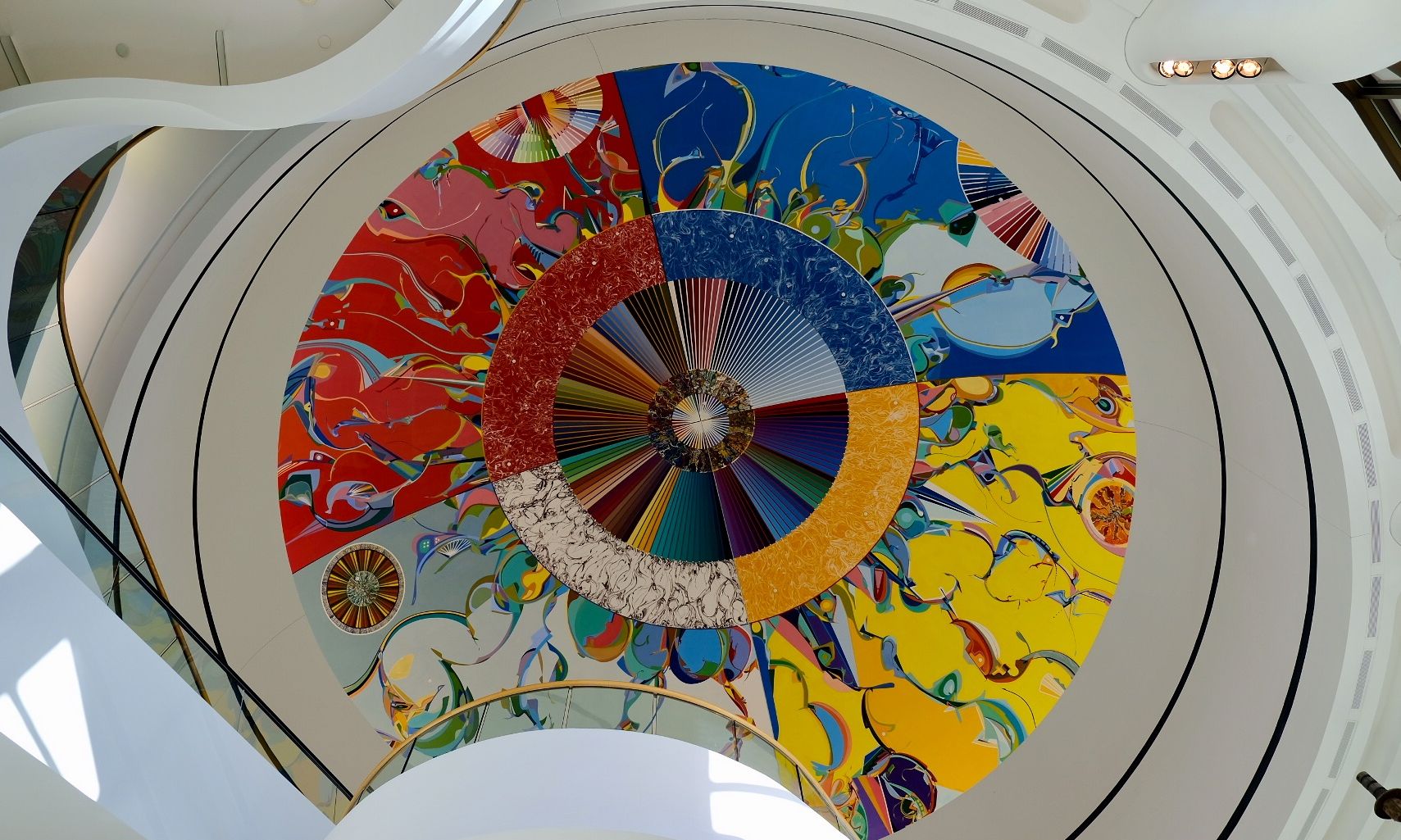Alex Janvier's Morning Star (1993) at the Canadian Museum of History, Gatineau, Quebec Photo: Joanne Clifford via Wikimedia Commons
Alex Janvier, a visionary painter based in Canada who combined abstraction with First Nations traditions to create his own unique style, died on 10 July at age 89. The Assembly of First Nations annual general meeting held a moment of silence in honour of the painter, who championed Native artists and paved the way for a new generation. Canadian prime minister Justin Trudeau wrote on X: “His art reflected so much of Canada’s history, including some of the hardest parts of our story.”
Janvier was born on 28 February 1935 on the Cold Lake Indian Reserve (now Cold Lake First Nations), near Alberta's Saskatchewan border almost 300km northeast of Edmonton. He was of Denesuline and Saulteaux descent. At the time, the so-called pass system was still in place—a government policy that restricted the movement of Indigenous peoples off reservations. Janvier's father, Harry Janvier, was the community’s last hereditary chief before elected officials became required under federal law. Janvier grew up with nine siblings. At age eight, he was sent to the Blue Quills Residential School about 100km southwest of Cold Lake.
“That kind of story does a lot of unusual things to our life,” Janvier once said of his time at the school. “It tears [apart] your language, culture and beliefs. They probably removed a lot of it.”
Even so, teachers noticed and encouraged Janvier’s artistic talent, and he began attending art classes at the University of Alberta in his early teens. He went on to study at the Provincial Institute of Technology and Art in Calgary (now the Alberta University of the Arts) under artists like Illingworth Kerr and Marion Nicoll—one of Canada’s earliest abstract painters.
Janvier made his living as a full-time painter and illustrator starting in 1962. He married Jacqueline Wolowski in 1968, and they had six children together. In 1973, Janvier helped found the Professional Native Indian Artists Inc. with fellow First Nations artists Norval Morrisseau, Daphne Odjig and Jackson Beardy—opening doors to mainstream galleries at a time when Native artists were often confined to ethnographic museums.
Inspired as much by patterns and colours of traditional Denesuline beadwork, hide painting and quill work as by the works of Paul Klee and Wassily Kandinsky, Janvier’s abstract work was often quite political.
Alex Janvier at the National Gallery of Canada for his major retrospective exhibition, March 2017 Photo: D. Gordon E. Robertson via Wikimedia Commons
His 1988 painting Lubicon, inflamed with angry reds, expressed his rage at the treatment of his people, as did a series about his experience at residential school. O’Kanada (1990), installed at the Royal Alberta Museum in Edmonton, was inspired by the Oka Crisis—a standoff between the Mohawk community and police over plans to build a golf course atop an Indigenous burial ground. In Janvier's 1993 Morning Star, painted into the dome of the Canadian Museum of History in Quebec, the artist said he represented Native history and the hope for reconciliation.
In 1998, Janvier designed a C$200 coin for the Royal Canadian Mint based on the legend of the white buffalo. His giant mosaic Iron Foot Place (2015) still greets hockey fans at Edmonton’s Rogers Place arena.
Janvier opened the Janvier Gallery in Cold Lake in 2003—a place where visitors could meet the artist while he took breaks from making work at his neighbouring studio. “When I die, I want to have a paintbrush in my hand,” he said in 2016.
Janvier received numerous awards in his lifetime, including the Order of Canada, the Governor General’s Award for Visual and Media Arts, the National Aboriginal Achievement Foundation’s Lifetime Achievement Award, the Queen Elizabeth II Diamond Jubilee Medal and membership in the Royal Canadian Academy of the Arts.
“Painting says it all for me,” Janvier said in 2012. “It is the Redmantalk in colour, in North America's language. Our Creator's voice in colour."
“Alex was a true visionary who helped break down the barriers that confined Indigenous art to anthropology,” the Anishinaabe curator Wanda Nanibush tells The Art Newspaper. “He was our fire talking about how Canada needed to pay the rent. He was a soft spirit following the cycles and colours of the world in his paintings.”
The Coast Salish artist Lawrence Paul Yuxweluptun, who first met Janvier in 1992 at the groundbreaking group exhibition Land, Spirit, Power at the National Gallery of Canada—where Janvier would have a retrospective in 2016—recalls Janvier saying his works were topographic. “He said he looked at the land as if he were an eagle flying down from above,” Yuxweluptun says. “He’s flying with the eagles now.”

